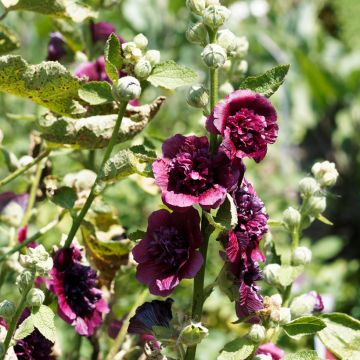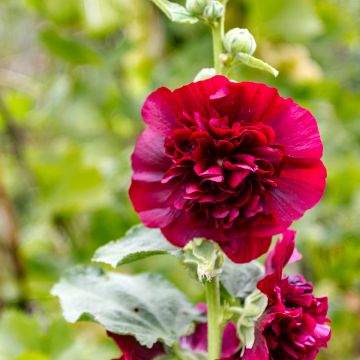

Alcea ficifolia Las Vegas - Rose trémière
Alcea ficifolia Las Vegas
Alcea ficifolia Las Vegas
Hollyhock 'Las Vegas', Fig-leaved hollyhock, Antwerp hollyhock
Sorry, but I haven't seen any growth since their plantings. I planted them on the south-facing front. It hasn't been cold since. I'm waiting.
Maurice, 03/04/2023
Special offer!
Receive a €20 voucher for any order over €90 (excluding delivery costs, credit notes, and plastic-free options)!
1- Add your favorite plants to your cart.
2- Once you have reached €90, confirm your order (you can even choose the delivery date!).
3- As soon as your order is shipped, you will receive an email containing your voucher code, valid for 3 months (90 days).
Your voucher is unique and can only be used once, for any order with a minimum value of €20, excluding delivery costs.
Can be combined with other current offers, non-divisible and non-refundable.
Home or relay delivery (depending on size and destination)
Schedule delivery date,
and select date in basket
This plant carries a 12 months recovery warranty
More information
We guarantee the quality of our plants for a full growing cycle, and will replace at our expense any plant that fails to recover under normal climatic and planting conditions.

Would this plant suit my garden?
Set up your Plantfit profile →
Description
Alcea ficifolia 'Las Vegas' is a beautiful variety of fig-leafed hollyhock, with vibrant colours and a slightly more compact habit. It is a short-lived but hardy perennial plant that is naturally resistant to rust. It boasts a long summer flowering period with variable colours depending on the plants. It produces long stems carrying numerous crepe-like flowers in unique shades of red, copper, brown, yellow, pink, and white. They charm with their lightness and somewhat naive flowering, showing elegance when placed at the back of borders or when covering the walls of an enclosed garden.
Alcea ficifolia 'Las Vegas' is a German horticultural variety. The fig-leafed hollyhock appears to be a subspecies of A. rosea, found in Iran and Siberia. It is also called A. rosea subsp. ficifolia. All these plants belong to the Malvaceae family. 'Las Vegas' is a tall, robust plant with distinctly and deeply lobed, rough leaves that resemble the leaves of this southern tree. It produces single flowers in a range of vibrant colours. The dark green foliage is healthy and disease-resistant. The flowering period lasts from May-June to August-September, starting earlier in warm climates and later in cooler climates. Each plant produces strong stems, 1.5 to 1.6m (5ft) tall, adorned with round flowers that have a crinkled and slightly translucent texture reminiscent of silk muslin. Throughout this period, they will attract bees and butterflies to your garden. The flowering is followed by numerous fruits filled with seeds that self-sow in unexpected areas: at the base of walls, in poor and rocky soils, in wall crevices, etc.
Commonly found in abandoned gardens or fallow fields in rural areas, hollyhocks are often grown at the back of borders or against a wall for protection against strong winds. The unique colours of Alcea ficifolia 'Las Vegas' will create beautiful combinations with light-flowering perennials such as gauras and perennial flax, or the grey foliage of wormwoods, for example. This plant is said to be tolerant to juglone, a substance secreted by walnut roots, so it might be possible to plant it at the base of a walnut tree, provided there is enough light.
Hollyhocks are edible plants. The flower buds can be eaten raw in salads and the young leaves can be eaten raw or cooked.
Good to know: hollyhocks are both ornamental and medicinal. Their seeds yield an oil with drying properties. Rich in mucilage, it is traditionally believed to have soothing, emollient, expectorant, laxative, and appetising properties, although milder compared to those of its cousin, the marsh mallow (Althea officinalis).
Report an error about the product description
Alcea ficifolia Las Vegas in pictures


Flowering
Foliage
Plant habit
Botanical data
Alcea
ficifolia
Las Vegas
Malvaceae
Hollyhock 'Las Vegas', Fig-leaved hollyhock, Antwerp hollyhock
Cultivar or hybrid
Other Alcea rosea - Hollyhocks
View all →Planting and care
Alcea ficifolia 'Las Vegas' appreciates hot conditions and sun. It can tolerate ordinary, clay, limestone, poor or rocky soil. These plants bear a taproot that does not appreciate being transplanted when developed. Care must be taken not to break this taproot during handling. The ficifolia variety is drought and cold resistant, while showing more resistance to rust than other hollyhocks.
Remove the faded flower stalks in October.
This short-lived perennial is often grown as a biennial. Its seeds are sown in autumn in warm regions, but in spring everywhere else.
Planting period
Intended location
Care
-
, onOrder confirmed
Reply from on Promesse de fleurs
Similar products
Haven't found what you were looking for?
Hardiness is the lowest winter temperature a plant can endure without suffering serious damage or even dying. However, hardiness is affected by location (a sheltered area, such as a patio), protection (winter cover) and soil type (hardiness is improved by well-drained soil).

Photo Sharing Terms & Conditions
In order to encourage gardeners to interact and share their experiences, Promesse de fleurs offers various media enabling content to be uploaded onto its Site - in particular via the ‘Photo sharing’ module.
The User agrees to refrain from:
- Posting any content that is illegal, prejudicial, insulting, racist, inciteful to hatred, revisionist, contrary to public decency, that infringes on privacy or on the privacy rights of third parties, in particular the publicity rights of persons and goods, intellectual property rights, or the right to privacy.
- Submitting content on behalf of a third party;
- Impersonate the identity of a third party and/or publish any personal information about a third party;
In general, the User undertakes to refrain from any unethical behaviour.
All Content (in particular text, comments, files, images, photos, videos, creative works, etc.), which may be subject to property or intellectual property rights, image or other private rights, shall remain the property of the User, subject to the limited rights granted by the terms of the licence granted by Promesse de fleurs as stated below. Users are at liberty to publish or not to publish such Content on the Site, notably via the ‘Photo Sharing’ facility, and accept that this Content shall be made public and freely accessible, notably on the Internet.
Users further acknowledge, undertake to have ,and guarantee that they hold all necessary rights and permissions to publish such material on the Site, in particular with regard to the legislation in force pertaining to any privacy, property, intellectual property, image, or contractual rights, or rights of any other nature. By publishing such Content on the Site, Users acknowledge accepting full liability as publishers of the Content within the meaning of the law, and grant Promesse de fleurs, free of charge, an inclusive, worldwide licence for the said Content for the entire duration of its publication, including all reproduction, representation, up/downloading, displaying, performing, transmission, and storage rights.
Users also grant permission for their name to be linked to the Content and accept that this link may not always be made available.
By engaging in posting material, Users consent to their Content becoming automatically accessible on the Internet, in particular on other sites and/or blogs and/or web pages of the Promesse de fleurs site, including in particular social pages and the Promesse de fleurs catalogue.
Users may secure the removal of entrusted content free of charge by issuing a simple request via our contact form.
The flowering period indicated on our website applies to countries and regions located in USDA zone 8 (France, the United Kingdom, Ireland, the Netherlands, etc.)
It will vary according to where you live:
- In zones 9 to 10 (Italy, Spain, Greece, etc.), flowering will occur about 2 to 4 weeks earlier.
- In zones 6 to 7 (Germany, Poland, Slovenia, and lower mountainous regions), flowering will be delayed by 2 to 3 weeks.
- In zone 5 (Central Europe, Scandinavia), blooming will be delayed by 3 to 5 weeks.
In temperate climates, pruning of spring-flowering shrubs (forsythia, spireas, etc.) should be done just after flowering.
Pruning of summer-flowering shrubs (Indian Lilac, Perovskia, etc.) can be done in winter or spring.
In cold regions as well as with frost-sensitive plants, avoid pruning too early when severe frosts may still occur.
The planting period indicated on our website applies to countries and regions located in USDA zone 8 (France, United Kingdom, Ireland, Netherlands).
It will vary according to where you live:
- In Mediterranean zones (Marseille, Madrid, Milan, etc.), autumn and winter are the best planting periods.
- In continental zones (Strasbourg, Munich, Vienna, etc.), delay planting by 2 to 3 weeks in spring and bring it forward by 2 to 4 weeks in autumn.
- In mountainous regions (the Alps, Pyrenees, Carpathians, etc.), it is best to plant in late spring (May-June) or late summer (August-September).
The harvesting period indicated on our website applies to countries and regions in USDA zone 8 (France, England, Ireland, the Netherlands).
In colder areas (Scandinavia, Poland, Austria...) fruit and vegetable harvests are likely to be delayed by 3-4 weeks.
In warmer areas (Italy, Spain, Greece, etc.), harvesting will probably take place earlier, depending on weather conditions.
The sowing periods indicated on our website apply to countries and regions within USDA Zone 8 (France, UK, Ireland, Netherlands).
In colder areas (Scandinavia, Poland, Austria...), delay any outdoor sowing by 3-4 weeks, or sow under glass.
In warmer climes (Italy, Spain, Greece, etc.), bring outdoor sowing forward by a few weeks.


















































